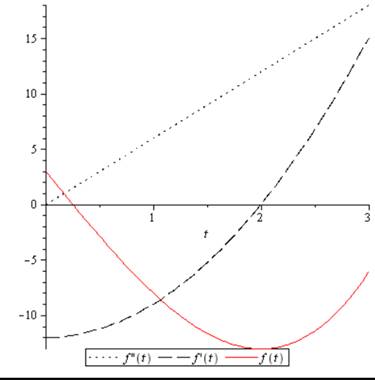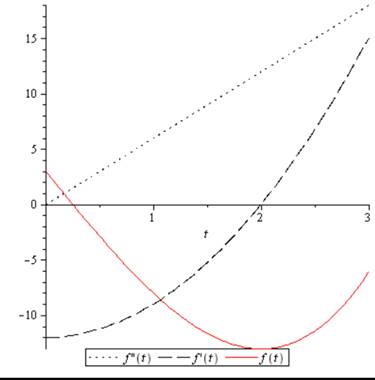
Concept explainers
(a)
To find: The velocity and the acceleration function.
(a)
Explanation of Solution
Given: The expression coordinate of particle is
Velocity is the derivation of the first position.
So, the expression for velocity is calculated as:
Acceleration is the second derivative of position. So,
Therefore, the velocity function is
(b)
To find: When the particle is moving upward and when it is moving downward.
(b)
Explanation of Solution
Given: The expression coordinate of particle is
Velocity is the derivation of the first position.
So, the expression for velocity is calculated as:
Equate the above equation to zero.
Plugging in the values lesser and greater than
Therefore, the particle is moving downward from the time
(c)
To find: The distance that the particle travels in the time interval.
(c)
Explanation of Solution
Given: The expression coordinate of particle is
Velocity is the derivation of the first position.
So, the expression for velocity is calculated as:
Equate the above equation to zero.
To find the total distance, break up the position function into two intervals
Hence,
(d)
To graph : The position, velocity and the acceleration function.
(d)
Explanation of Solution
Given: The expression coordinate of particle is
The graph of position, velocity and the acceleration function on a single plane is shown in figure below.

Figure (1)
Therefore, the graph of position, velocity and the acceleration function on a single plane is shown in Figure (1).
(e)
To graph : When the particle is speeding up and speeding down..
(e)
Explanation of Solution
Given: The expression coordinate of particle is
The graph of position, velocity and the acceleration function on a single plane is shown in figure below.

Figure (1)
From the graph both the acceleration and velocity have the same sign after
Hence, the particle is speeding up during
Chapter 3 Solutions
Single Variable Calculus: Concepts and Contexts, Enhanced Edition
- Can you help explain what I did based on partial fractions decomposition?arrow_forwardSuppose that a particle moves along a straight line with velocity v (t) = 62t, where 0 < t <3 (v(t) in meters per second, t in seconds). Find the displacement d (t) at time t and the displacement up to t = 3. d(t) ds = ["v (s) da = { The displacement up to t = 3 is d(3)- meters.arrow_forwardLet f (x) = x², a 3, and b = = 4. Answer exactly. a. Find the average value fave of f between a and b. fave b. Find a point c where f (c) = fave. Enter only one of the possible values for c. c=arrow_forward
- please do Q3arrow_forwardUse the properties of logarithms, given that In(2) = 0.6931 and In(3) = 1.0986, to approximate the logarithm. Use a calculator to confirm your approximations. (Round your answers to four decimal places.) (a) In(0.75) (b) In(24) (c) In(18) 1 (d) In ≈ 2 72arrow_forwardFind the indefinite integral. (Remember the constant of integration.) √tan(8x) tan(8x) sec²(8x) dxarrow_forward
- Find the indefinite integral by making a change of variables. (Remember the constant of integration.) √(x+4) 4)√6-x dxarrow_forwarda -> f(x) = f(x) = [x] show that whether f is continuous function or not(by using theorem) Muslim_mathsarrow_forwardUse Green's Theorem to evaluate F. dr, where F = (√+4y, 2x + √√) and C consists of the arc of the curve y = 4x - x² from (0,0) to (4,0) and the line segment from (4,0) to (0,0).arrow_forward
 Calculus: Early TranscendentalsCalculusISBN:9781285741550Author:James StewartPublisher:Cengage Learning
Calculus: Early TranscendentalsCalculusISBN:9781285741550Author:James StewartPublisher:Cengage Learning Thomas' Calculus (14th Edition)CalculusISBN:9780134438986Author:Joel R. Hass, Christopher E. Heil, Maurice D. WeirPublisher:PEARSON
Thomas' Calculus (14th Edition)CalculusISBN:9780134438986Author:Joel R. Hass, Christopher E. Heil, Maurice D. WeirPublisher:PEARSON Calculus: Early Transcendentals (3rd Edition)CalculusISBN:9780134763644Author:William L. Briggs, Lyle Cochran, Bernard Gillett, Eric SchulzPublisher:PEARSON
Calculus: Early Transcendentals (3rd Edition)CalculusISBN:9780134763644Author:William L. Briggs, Lyle Cochran, Bernard Gillett, Eric SchulzPublisher:PEARSON Calculus: Early TranscendentalsCalculusISBN:9781319050740Author:Jon Rogawski, Colin Adams, Robert FranzosaPublisher:W. H. Freeman
Calculus: Early TranscendentalsCalculusISBN:9781319050740Author:Jon Rogawski, Colin Adams, Robert FranzosaPublisher:W. H. Freeman
 Calculus: Early Transcendental FunctionsCalculusISBN:9781337552516Author:Ron Larson, Bruce H. EdwardsPublisher:Cengage Learning
Calculus: Early Transcendental FunctionsCalculusISBN:9781337552516Author:Ron Larson, Bruce H. EdwardsPublisher:Cengage Learning





